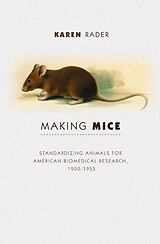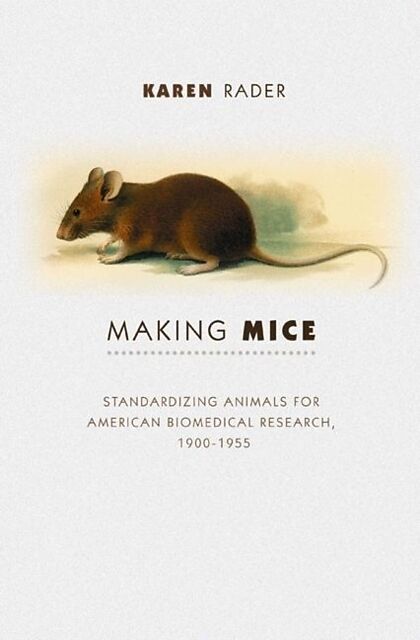Making Mice
Einband:
Fester Einband
EAN:
9780691016368
Untertitel:
Standardizing Animals for American Biomedical Research, 1900-1955
Autor:
Karen Rader
Herausgeber:
Princeton University Press
Anzahl Seiten:
320
Erscheinungsdatum:
21.03.2004
ISBN:
0691016364
Zusatztext "Rader's carefully researched and well-produced book will be indispensable reading for everyone interested in the laboratory mouse and more generally in the tools and practices of twentieth-century biomedicine." ---Soraya de Chadarevian, Journal of the History of medicine and Allied Sciences Informationen zum Autor Karen Rader Klappentext Making Mice blends scientific biography, institutional history, and cultural history to show how genetically standardized mice came to play a central role in contemporary American biomedical research. Karen Rader introduces us to mouse "fanciers" who bred mice for different characteristics, to scientific entrepreneurs like geneticist C. C. Little, and to the emerging structures of modern biomedical research centered around the National Institutes of Health. Throughout Making Mice, Rader explains how the story of mouse research illuminates our understanding of key issues in the history of science such as the role of model organisms in furthering scientific thought. Ultimately, genetically standardized mice became icons of standardization in biomedicine by successfully negotiating the tension between the natural and the man-made in experimental practice. This book will become a landmark work for its understanding of the cultural and institutional origins of modern biomedical research. It will appeal not only to historians of science but also to biologists and medical researchers. Zusammenfassung Blends scientific biography, institutional history, and cultural history to show how genetically standardized mice came to play a central role in contemporary American biomedical research. This work introduces us to mouse "fanciers" who bred mice for different characteristics, and to the structures of modern biomedical research. Inhaltsverzeichnis Illustrations ix Acknowledgments xiii Abbreviations xvii INTRODUCTION: Why Mice? 1 CHAPTER ONE: Mice! Medicine! and Genetics: From Pet Rodents to Research Materials (1900-21) 25 CHAPTER TWO: Experiment and Change: Institutionalizing Inbred Mice (1922-30) 59 CHAPTER THREE: Mice for Sale: Commodifying Research Animals (1930-33) 97 CHAPTER FOUR: A New Deal for Mice: Biomedicine as Big Science (1933-40) 135 CHAPTER FIVE: R X Mouse : JAX Mice in Cancer Research (1938-55) 175 CHAPTER SIX: Mouse Genetics as Public Policy: Radiation Risk in Cold War America (1946-56) 221 EPILOGUE: Animals and the New Biology: Oncomouse and Beyond 251 Bibliography 269 Index 293 ...
Autorentext
Karen Rader is Marilyn Simpson Chair of Science and Society at Sarah Lawrence College.
Klappentext
Making Mice blends scientific biography, institutional history, and cultural history to show how genetically standardized mice came to play a central role in contemporary American biomedical research. Karen Rader introduces us to mouse "fanciers" who bred mice for different characteristics, to scientific entrepreneurs like geneticist C. C. Little, and to the emerging structures of modern biomedical research centered around the National Institutes of Health. Throughout Making Mice, Rader explains how the story of mouse research illuminates our understanding of key issues in the history of science such as the role of model organisms in furthering scientific thought. Ultimately, genetically standardized mice became icons of standardization in biomedicine by successfully negotiating the tension between the natural and the man-made in experimental practice. This book will become a landmark work for its understanding of the cultural and institutional origins of modern biomedical research. It will appeal not only to historians of science but also to biologists and medical researchers.
Zusammenfassung
Making Mice blends scientific biography, institutional history, and cultural history to show how genetically standardized mice came to play a central role in contemporary American biomedical research.
Karen Rader introduces us to mouse "fanciers" who bred mice for different characteristics, to scientific entrepreneurs like geneticist C. C. Little, and to the emerging structures of modern biomedical research centered around the National Institutes of Health. Throughout Making Mice, Rader explains how the story of mouse research illuminates our understanding of key issues in the history of science such as the role of model organisms in furthering scientific thought. Ultimately, genetically standardized mice became icons of standardization in biomedicine by successfully negotiating the tension between the natural and the man-made in experimental practice.
This book will become a landmark work for its understanding of the cultural and institutional origins of modern biomedical research. It will appeal not only to historians of science but also to biologists and medical researchers.
Inhalt
Illustrations ix Acknowledgments xiii Abbreviations xvii INTRODUCTION: Why Mice? 1 CHAPTER ONE: Mice, Medicine, and Genetics: From Pet Rodents to Research Materials (1900-21) 25 CHAPTER TWO: Experiment and Change: Institutionalizing Inbred Mice (1922-30) 59 CHAPTER THREE: Mice for Sale: Commodifying Research Animals (1930-33) 97 CHAPTER FOUR: A New Deal for Mice: Biomedicine as Big Science (1933-40) 135 CHAPTER FIVE: R X Mouse : JAX Mice in Cancer Research (1938-55) 175 CHAPTER SIX: Mouse Genetics as Public Policy: Radiation Risk in Cold War America (1946-56) 221 EPILOGUE: Animals and the New Biology: Oncomouse and Beyond 251 Bibliography 269 Index 293

Leider konnten wir für diesen Artikel keine Preise ermitteln ...
billigbuch.ch sucht jetzt für Sie die besten Angebote ...
Die aktuellen Verkaufspreise von 6 Onlineshops werden in Realtime abgefragt.
Sie können das gewünschte Produkt anschliessend direkt beim Anbieter Ihrer Wahl bestellen.
Loading...
Die aktuellen Verkaufspreise von 6 Onlineshops werden in Realtime abgefragt.
Sie können das gewünschte Produkt anschliessend direkt beim Anbieter Ihrer Wahl bestellen.
| # | Onlineshop | Preis CHF | Versand CHF | Total CHF | ||
|---|---|---|---|---|---|---|
| 1 | Seller | 0.00 | 0.00 | 0.00 |
